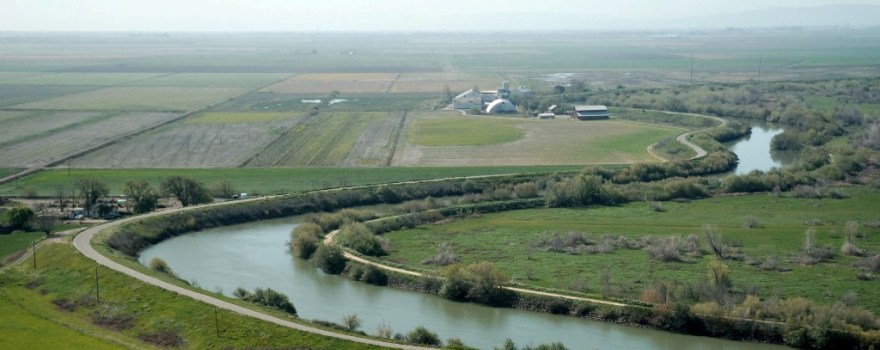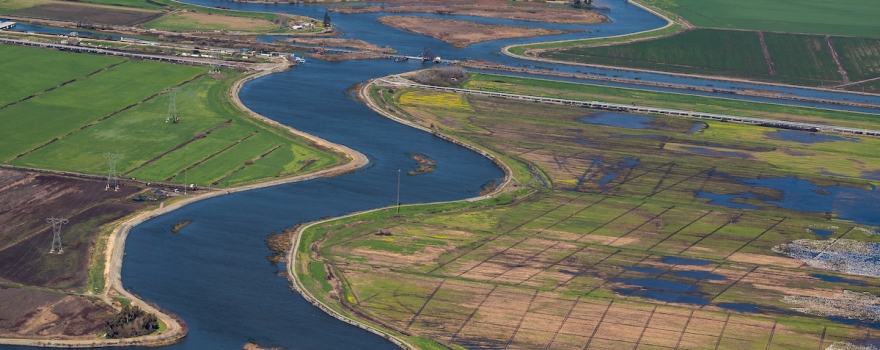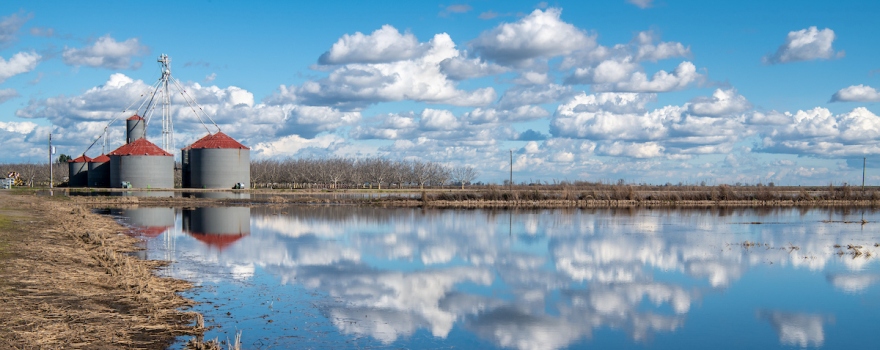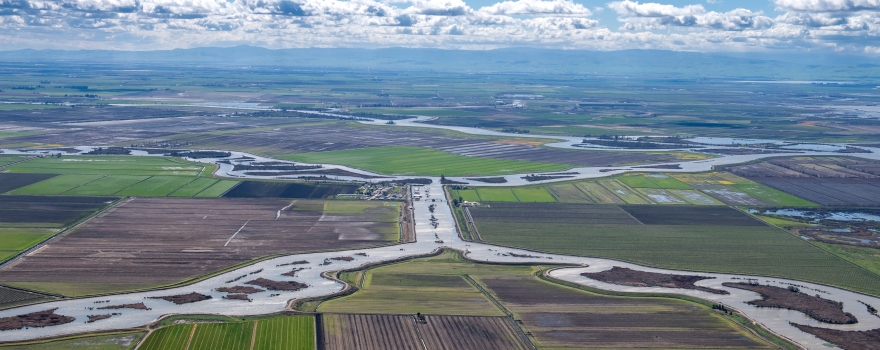 Ms. Tatayon discusses the role of the Delta Stewardship Council, her goals as chair, and the Delta Plan 5 year review
Ms. Tatayon discusses the role of the Delta Stewardship Council, her goals as chair, and the Delta Plan 5 year review
This article was written by Lisa Beutler; it appeared first in The Water Report and is republished here with permission.
Susan Tatayon presides over the Delta Stewardship Council (Council), one of a trio of agencies responsible for stewardship of the Sacramento-San Joaquin Delta (Delta). The Delta and its stressed environs serve as the major hub for California’s water management system.
 Chair Tatayon, appointed to the Council by Govenor Jerry Brown in 2014, and reappointed in 2018, generously spared time on May 30, 2019 to talk with The Water Report about the Council, its roles and her goals for her term as Chair. She assumed the role of Chair beginning January 1, 2019 after serving three years as Vice-Chair. Her current term will expire February 2, 2022.
Chair Tatayon, appointed to the Council by Govenor Jerry Brown in 2014, and reappointed in 2018, generously spared time on May 30, 2019 to talk with The Water Report about the Council, its roles and her goals for her term as Chair. She assumed the role of Chair beginning January 1, 2019 after serving three years as Vice-Chair. Her current term will expire February 2, 2022.
Upon being thanked for her time, Tatayon immediately (and characteristically) expressed appreciation for the opportunity to share up-to-date information about the Council and its current direction. She noted that in their recent planning session, the Council had expressly decided it would be important to conduct more outreach and build both the general public’s and concerned decision-makers’ understanding of the Council, its role, and the evolving Delta Plan.
Tatayon’s background and experience make her particularly well-suited for tackling the responsibilities of Council Chair. She has served in a number of increasingly responsible roles in the state and federal government as well as working in the private sector and at an environmental non-profit. To this we could add too many volunteer roles to succinctly recount. A common thread in all of her history is that she was often asked to tackle projects that required new approaches or to accomplish what had never even been done before. In each case she encountered the challenges as opportunities rather than burdens. She noted that one of these challenges was formative in developing her early views as a pragmatic environmentalist.
Those that know Tatayon will readily reference her moderated, gracious style and thoughtful attentiveness. They will simultaneously describe a firm resolve and clarity in which she is able to recast dilemmas to possibilities. The latter is evidenced in the Chair’s own description of her work experiences.
Delta Agencies
 Encompassing over half a million acres, the Delta’s legislatively-defined boundaries extend over portions of five California Counties.
Encompassing over half a million acres, the Delta’s legislatively-defined boundaries extend over portions of five California Counties.
The bifurcated governance arrangement for the Delta was created by the Sacramento-San Joaquin Delta Reform Act of 2009 (Act) — the Legislature’s response to what is considered one of California’s thorniest areas of water management concerns. The primary focus of the Act is the requirement for creation of comprehensive, long-term management plan for the Delta (the “Delta Plan”).
The Delta Plan advances the state’s coequal goals for the Delta: 1) to improve statewide water supply reliability; and 2) to protect and restore a vibrant and healthy Delta ecosystem. These goals are to be accomplished in a manner that preserves, protects, and enhances the unique agricultural, cultural, and recreational characteristics of the Delta.
More agencies are involved in management of the Delta than can be easily listed here. However, three Sacramento-San Joaquin Delta agencies: 1) the Council; 2) the Delta Protection Commission (DPC); and 3) the Sacramento-San Joaquin Delta Conservancy (Conservancy) — are assigned very specific and pivotal responsibilities under the Act (see sidebar below).
We began by asking about the differences between these three Agencies and their roles. Tatayon broke into a smile, replying this is probably the most common question she gets, even from water and natural resources executives. She explained that the Council and its sister agencies, the DPC and the Conservancy all share the common role of implementing the Delta Plan. Beyond that, the Council has several distinctive roles, the most prominent being its responsibility to develop, adopt, and commence implementation of the Delta Plan. Related to this, the Council is responsible for appointment of an Independent Science Board (ISB). The ISB and the Council’s science program work to support use of the best available science on Delta issues.
The Council also provides collaborative leadership in convening all the partners needed to implement the Delta Plan, and serves as a regulator. As a regulator they act as the final arbiter of whether-or-not any Delta-related projects advanced by state and local agencies are consistent with the Delta Plan.
Tatayon briefly detailed the legislatively-defined roles of the Delta Agencies. She noted the role of the Conservancy in ecosystem restoration and of the DPC as a land use planning body and service as a voice for the Delta’s residents, visitors, and businesses.
Sacramento-San Joaquin Delta Agencies
Delta Stewardship Council: As an independent state agency the Council was required to, on or before January 1, 2012, develop, adopt, and commence implementation of a comprehensive management plan for the Delta (Delta Plan). State or local public agencies that propose to undertake certain proposed actions within the boundaries of the Delta or the Suisun Marsh must prepare and submit to the Council a specified written certification of consistency with the Delta Plan prior to taking those actions. As the consistency determination is a self-certification process, the Council oversees an appeal process whereby a person may claim that a proposed action is inconsistent with the Delta Plan, and request a determination of Consistency by the Council. The Council is also responsible for providing a charge to and appointing the members of the Delta Independent Science Board. See: http://deltacouncil.ca.gov/
Delta Independent Science Board (Delta ISB): The Delta ISB is a standing board of nationally or internationally prominent scientists with appropriate expertise to evaluate the broad range of scientific programs that support adaptive management of the Delta. The Delta ISB provides oversight of the scientific research, monitoring, and assessment programs that support adaptive management of the Delta through periodic reviews of each of those programs. The overall objective of Delta ISB oversight is to help make the science underlying Bay-Delta programs, the application of that science, and the technical aspects of those programs the best that they can be. See: http://deltacouncil.ca.gov/science-board/delta-independent-science-board
Delta Conservancy: The Conservancy acts as the primary state agency to implement ecosystem restoration in the Delta and to support efforts that advance environmental protection and the economic well-being of Delta residents. As established within the Natural Resources Agency, it holds the authority to acquire real property interests from willing sellers or transferors and is required to use conservation easements to accomplish ecosystem restoration whenever feasible. A Sacramento-San Joaquin Delta Conservancy Fund in the State Treasury upon appropriation, finances projects, including ecosystem restoration and economic sustainability projects. See: http://deltaconservancy.ca.gov/
Delta Protection Commission: The oldest of the agencies, the Commission was created by the Delta Protection Act of 1992 and reconfigured by the Sacramento-San Joaquin Delta Reform Act of 2009. The Commission is responsible for the preparation and adoption of a comprehensive longterm resource management plan for about 500,000 acres of legally defined Delta lands (called the Primary Zone). The Act of 2009 also required that the Commission prepare and adopt an economic sustainability plan, which is reviewed, and as necessary, amended every 5 years. A significant role of the Commission is to provide a venue for the Delta’s residents, visitors and businesses to provide input on matters related to the Delta. Like the Council, it serves as an appellate body for actions taken by a local government or other local agency for lands located within the Primary Zone viewed as inconsistent with the resource management plan, or other sections of the Protection Act for which the commission is responsible. It also informs the decision making of sister agencies on a variety of issues such as flood management and recreation investment as well activities related to the Commission’s plan s and jurisdiction. The Commission also comments on projects in the legally defined Secondary Zone (primarily the urban areas within the Delta) that have the potential to impact the Primary Zone. See: http://delta.ca.gov/
Less Understood and Misunderstood Roles
Tatayon felt that some of the less known or understood Council functions included its ability to provide early consultation to project proponents. This consultation supports agencies in aligning their endeavors to be consistent with the Delta Plan. The Council is also able to convene expert panels and facilitate peer review.
Tatayon was particularly proud of its Delta Science and California Sea Grant fellowship programs. She felt support of fellows is a wise, long-term, generational investment in ensuring that required skills and knowledge will be available in the coming decades.
Another little-publicized role is the Council’s leadership of the Delta Plan Interagency Implementation Committee (DPIIC). The DPIIC strives to facilitate Delta Plan implementation with state and federal agencies that have a role in the Delta. The DPIIC focuses on progress in achieving the coequal goals. This progress is defined as “water supply reliability, Delta ecosystem health and restoration, Delta as a Place, and best available science in support of ‘One Delta, One Science.’”
As relates to misunderstood roles, an obvious one is a general perception that the Council approves projects. Tatayon affirmed that this is not the case. Instead, the Council oversees a certification process for demonstrating consistency with the Delta Plan. As outlined in the Delta Reform Act, this means that a state or local agency proposing to undertake a qualifying action, called a “covered action” (see sidebar below), must submit to the Council a written certification of consistency. This certification includes detailed findings as to whether the covered action is consistent with the Delta Plan. Any person may appeal a certification of consistency to the Council. At this point the Council would determine if the action is consistent, and if not, return it to the proponent.
Covered Actions & Projects
Covered Actions
Water Code Section 85057.5(a) describes a covered action as a plan, program, or project that meets all of the following conditions:
• Will occur, in whole or in part, within the boundaries of the Delta or Suisun Marsh;
• Will be carried out, approved, or funded by the state or a local public agency;
• Is covered by one or more provisions of the Delta Plan;
• Will have a significant impact on the achievement of one or both of the coequal goals or the implementation of government-sponsored flood control programs to reduce risks to people, property, and state interests in the Delta.
Definition of a Project Under the Delta Act
Public Resources Code Section 21065 describes a project as an activity which may cause either a direct physical change in the environment, or a reasonably foreseeable indirect physical change in the environment, and which is any of the following:
• An activity directly undertaken by any public agency.
• An activity undertaken by a person which is supported, in whole or in part, through contracts, grants, subsidies, loans, or other forms of assistance from one or more public agencies.
• An activity that involves the issuance to a person of a lease, permit, license, certificate, or other entitlement for use by one or more public agencies.

Council Chairs Past & Present
Tatayon is the third Council Chair to serve in the relatively new agency. Council members select a chairperson from among their members who may serve for up to four years. Given the distinctive styles and approaches of the Chairs, we asked what she saw as the similarities and differences.
She began by complimenting the previous two leaders and noted how each was exactly the right person for the time in which they served. Chair Phil Issenberg brought the firm hand required for launching of an enterprise. She described how he was able to deftly navigate the intricacies of Delta issues, skillfully address tough issues, and ask the pointed and provocative questions needed to advance the thinking of everyone involved.
Her personal appreciation for the leadership of Chair Randy Fiorini was apparent as she described his gentlemanly and masterful diplomacy. She explained his careful, considerate and thoughtful approach as an interest based negotiator who brought people to the table and allowed the Council to confront well publicized and controversial issues.
Tatayon described her own style as one of facilitating collaboration. She enjoys bringing a full range of interests into the room, leveraging the strengths of each, and exploring multiple points of view. She described this approach as sometimes messy but finds that the confluence of ideas is generative and produces possibilities that would not otherwise have been considered. She also noted that when everyone is part of the decision crafting process they accept more ownership for implementation.
Goals as Chair
In terms of her own goals as Chair, Tatayon plans to focus on actual implementation of the Delta Plan, which includes reducing reliance on the Delta and building regional self-reliance. Under California Water Code, reduction of reliance on the Delta means reducing “reliance on the Delta in meeting California’s future water supply needs through a statewide strategy of investing in improved regional supplies, conservation and water use efficiency.” Regions dependent on water from the Delta watershed are required to “improve its regional self-reliance for water through investment in water use efficiency, water recycling, advanced water technologies, local and regional water supply projects and improved regional coordination of local and regional water supply efforts.”
In Tatayon’s view, this will require increasing awareness of the Plan and its statewide relevance. She is also providing support for implementation of the Governor’s recent executive order to build a water resilience portfolio.
Another goal is to be engaged with advancing ecosystem restoration in the Delta. Tatayon believes she will be able to provide leadership to encourage approaches that ensure natural capital and assets are an integrated element of Delta initiatives rather than a “nice to have” or obligatory mitigation approach. She feels that this reframing of thinking will be critical in addressing the impacts of climate change. She is optimistic about recent efforts to integrate flood and floodplain management with groundwater recharge efforts and stressed how this helps recast opportunities for water storage and operations.
Tatayon also looks forward to supporting related integrated planning processes, like development of the California Water Plan Updates.

Delta Science
In surveys and other assessments, the Council’s work in promoting the use of best available science is universally well regarded. We asked the Chair about how she planned to focus on and/or leverage this expertise and reputation. She was very enthusiastic about this aspect of the Council’s work and particularly the 2017-2021 Science Action Agenda and the Council-led collaborative, multi-agency science funding initiative.
 Tatayon again referenced the need for climate change adaptation strategies and how important Delta monitoring programs — along with the joint efforts with Interagency Ecological Program (IEP) — will be in that endeavor. The IEP, a consortium of State and federal agencies, has been conducting cooperative ecological investigations since the 1970s and provides ecological information for management of the Bay-Delta ecosystem and the water that flows through it.
Tatayon again referenced the need for climate change adaptation strategies and how important Delta monitoring programs — along with the joint efforts with Interagency Ecological Program (IEP) — will be in that endeavor. The IEP, a consortium of State and federal agencies, has been conducting cooperative ecological investigations since the 1970s and provides ecological information for management of the Bay-Delta ecosystem and the water that flows through it.
A recent addition to the science agenda is more work on exploring Social Science. Tatayon finds that just focusing on the resource is not enough — better understanding the human element of the equation will be key to the Council’s success.
Amendments to the Delta Plan
When adopted by the Council in May 2013, it was always anticipated the Plan would need periodic reviews and updates in response to changing circumstances and conditions in the Delta. The Plan was first amended in February 2016 to include an initial set of refined performance measures. In September 2016 the Plan was amended to exempt single-year water transfers from consideration as covered actions. A third series of amendments were adopted in April 2018 that: addressed conveyance, storage, and operations; updated a section regarding the Delta Levees Investment Strategy; and added a Mitigation Monitoring and Reporting Program as a Plan appendix — among other topics.
The Council is now working with partner agencies, stakeholders, and the public to build upon, further refine, and amend Chapter 4 of the Delta Plan. This chapter includes regulations covering: flow; introduction of nonnative invasive species; and criteria for priority restoration sites.
We asked how Plan amendments would help shape what happens moving forward. To this Tatayon robustly returned with the question, “Do you know how much work it is to complete an amendment?”
While presented with good humor, the retort emphasized the extraordinary amount of work it indeed involves. She outlined the need for environmental reviews and the associated requirements for approvals of regulatory actions by the State’s Office of Administrative Law. Her final point being that no Chair would choose to undertake an amendments process without a clear case to do so.
In the case of the Chapter 4 amendment, Tatayon felt that it is critical for the Delta Plan to reflect the evolving understanding of climate change and its impacts. As described in Council documents, “The amendment is intended to consider the past and future effects of climate change and sea level rise, incorporate lessons learned about adaptive management of the Delta ecosystem, identify best practices, address needed institutional changes to improve implementation of restoration actions, and be informed by the best available interdisciplinary science.”
Short History of Lengthy Delta Conveyance Proposals
Planning documents dating back to 1917 suggested ways to move water from water rich Northern California to water scarce regions. The eventual engineered solutions to move water became reliant on dams and the natural infrastructure provided by river systems and the Sacramento-San Joaquin Delta. Today water is pumped from the Delta and moved further along through a canal system. Yet, from the time of construction forward, some questioned the use of the Delta water in this manner.
By 1957 the California Water Plan referenced an eventual need to develop an alternative to a Delta conveyance. Later Water Plans included in predictions of water supply the completion of a peripheral canal (a system that by-passes the Delta) for conveyance. In 1980 Governor Jerry Brown directed the California Department of Water Resources (CDWR) to initiate construction of the peripheral canal. The project was stopped in a 1982 by a referendum which had brought the issue before the voters in a hotly contested election.
Over the years, multiple proposals to address a growing set of problems created by use of the Delta for conveyance continued to be explored. In 2000, a 30-year plan for Delta management and restoration was drafted. Implementation of the plan was ultimately pledged by 25 state and federal agencies with expertise to manage the complex program. According to public records, this plan, set forth in a federal programmatic Record of Decision, “laid out a science-based planning process through which the participating agencies were able to make and implement better, more informed decisions and actions on future projects and programs.” Two years later, the California Bay-Delta Authority was created to oversee the program’s implementation and Congress adopted the plan in 2004.
Efforts continued to seek resolution of Delta issues. In 2006, Governor Schwarzenegger convened a Delta Vision Task force that after extensive input released a Strategic Plan in 2008. Informed by this process, the 2009 Delta Reform Act (Act) states the Delta Plan (in legislation now required to be prepared by the Council) “shall promote options for new and improved infrastructure relating to the water conveyance in the Delta” — among other things.
After exploring their options, in 2015, the Brown administration proposed a California Water Fix that would have created two (twin) 30-mile tunnels to convey water around the Delta. CDWR proceeded with developing planning materials and, as required under the Act, self-certified that the project was consistent with this Delta Plan. CDWR’s self-certification was appealed by nine parties. In October 2018, the Council staff issued a draft determination that not enough evidence existed in the record to support CDWR’s determination and made a recommendation that the Council return the matter back to CDWR. On December 7, 2018, CDWR withdrew its Certification of Consistency. This action allowed the Delta Stewardship Council Executive Officer to dismiss the appeals because they no longer raised issues before the Council.
As noted in the interview, a more recent Executive Order from the Governor references further consideration of a single tunnel.
Delta Tunnel
The Delta serves as the hub of the State’s water transportation system and several proposals to find ways to move water around the hub through canals and twin-tunnels have been examined and dismissed. New proposals are being examined to consider an alternative to Delta conveyance that would only include one tunnel. An April 2019 Governor’s Executive Order on Water Resiliency specifically references this concept. Given this history, no Delta interview would be complete without inquiring about the proposals to build a tunnel.
We asked what the Chair saw as the Council’s role in determining a Delta conveyance project. Tatayon immediately referenced the 2018 Plan amendments and encouraged anyone wanting to know more about what the Council would examine should it respond to an appeal on a consistency determination, to read the Delta Plan Chapter 3 sections on conveyance, storage and operations.
Delta Plan Chapter 3: Water Supply Principles
Delta Plan notes on a more reliable water supply for California
(as amended April 26, 2018)*
Delta Plan Chapter 3 provides an overview of California’s water context including the special role of the Sacramento-San Joaquin Delta (Delta) in California’s water.
Under the Delta Plan, four core water strategies must be implemented throughout the state to achieve the coequal goal of providing a more reliable water supply for California:
• Increase water conservation and expand local and regional supplies
• Improve groundwater management
• Improve conveyance and expand storage
• Improve water management information
In 2018, the Delta Stewardship Council amended the Delta Plan to promote options for water conveyance, storage systems, and the operation of both based on historical information and the best currently available science. The amendment recommendations are based upon the 19 Principles for Water Conveyance in the Delta, Storage Systems, and for the Operation of Both to Achieve the Coequal Goals.
19 Principles (abbreviated)*
1) New or improved Delta conveyance infrastructure should enhance the Delta ecosystem, including restoring more natural flows, protect or enhance water quality, and increase reliability.
2) Flexibility is key to new or improved Delta conveyance infrastructure.
3) Conveyance improvements should be able to adapt to changing conditions both near-term and in the future while continuing to provide benefits to the ecosystem and reliably convey available water supplies.
4) New or improved Delta conveyance infrastructure should increase resiliency of the state’s water supply systems in the face of future threats related to climate change and levee failures.
5) To maximize benefits, new Delta conveyance infrastructure should be integrated with new and expanded storage projects, increased water-use efficiency and conservation improved groundwater management; and restoration of the structure and function of some key Delta ecosystems.
6) New or expanded water storage projects above and below the Delta are necessary.
7) New or expanded storage projects should be cost effective.
8) Groundwater storage opportunities should be protected.
9) New or expanded storage projects should provide both immediate and enduring ecosystem and water supply benefits.
10) New or expanded water storage projects are part of a system and should support a comprehensive approach to managing the water cycle.
11) Water exported from the Delta should more closely match water supplies available to be exported.
12) Storage and conveyance should be operated by storing water in wet periods and reducing diversions in dry periods to protect water quality in the Delta, provide more natural, functional flows, and enhance Delta inflows and outflows.
13) Operational decisions should be based upon more accurate, timely, and transparent water accounting and budgeting.
14) Additional water supplies can be derived from more efficient reoperation of existing infrastructure.
15) Water storage operational guidelines should adopt a multi-year planning horizon to ensure adequate carryover of stored water in surface and groundwater reservoirs at the end of each water year to buffer against multiple dry years.
16) Surface and groundwater storage, whenever feasible, should be operated conjunctively to reduce long term groundwater basin overdraft and improve groundwater basin recharge.
17) Conveyance, storage and operation of infrastructure should provide net benefits to the ecosystem, not just protecting the ecosystem from further degradation.
18) Operation of storage and Delta conveyance infrastructure should be informed by best available science, adequately monitored and evaluated, and adaptively managed to ensure progress towards well-defined performance measures.
19) Ecosystem benefits should be assured through contracts, operations and governance protocols, or other enforceable agreements.
*As Summarized from the State of California, Delta Stewardship Council Delta Plan Chapter 3 – A More Reliable Water Supply for California (as amended April 26, 2018) and supporting documents.
Delta Plan Five Year Review
A formal Five-Year Review process, including stakeholder input, was recently drafted. We asked the Chair what she found particularly interesting or noteworthy about the review preliminary findings.
Several issues stood out for her. First was the clear consensus among all the reviewers about the critical need to address climate change. She felt the overwhelming emphasis of this topic by stakeholders provided momentum to the State’s goals and actions to respond and adapt.
A second highlight was the need for the Council to increase its communications across all sectors. She observed the heartfelt request of the Delta stakeholders to have a larger voice in the process. She equally noted that a lack of awareness and misunderstandings by those outside of the Delta undercut needed statewide support. She was also struck by the importance of increasing communications with those that have traditionally been less engaged in Delta discussions such as tribes and the underserved and disadvantaged communities. She believes that these groups, both inside and outside of the Delta, have relevant and important perspectives.
Tatayon also referenced some strategic planning the Council engaged in last March. The Council collectively, in addition to the topics she had already listed, wanted to increase the clarity of linkages between the Council’s science endeavors and policy, and amplify the role of DPIIC.

A Water Pioneer
In closing, we sought to learn more about Tatayon’s reflections on her own pioneering career trajectory and what lessons learned or advice she might offer to those starting out. Demonstrating her humility, she was genuinely perplexed by the question and replied that she never considered herself a pioneer. We spent a few minutes discussing what pioneers do, pointing out that her own series of accomplishments involved changing the way things were done or forging a path forward on things that had never been done before.
We suggested that this probably qualified as pioneering. With this clarification and definition, she offered several pieces of advice.
First she encouraged those embarking on new endeavors to become fully aware of what they are trying to accomplish. She explained there will almost always be a need to adjust and change course as an effort evolves but keeping an eye on the overarching goal will help achieve results.
Tatayon advised that those wishing to build a career should not wait for the assignment. She shared that she was always asking what she might be able to do to help and it was through this process that some of her most extraordinary opportunities emerged.
Finally, she offered that there could be unknown benefits in embracing the mundane. She offered as an example an assignment she had been given that, in the view of others in the group, was tedious and mind numbing. It was this very experience, and the deep exposure to new perspectives it provided, that was among the most transformative of her early career.
In closing she again expressed appreciation for the opportunity to share the Council’s story.
This article was written by Lisa Beutler; it appeared first in The Water Report and is republished here with permission. Contact: Lisa Beutler, Stantec, 916/ 418-8257 or Lisa.Beutler@stantec.com
 Sign up for daily email service and you’ll never miss a post!
Sign up for daily email service and you’ll never miss a post!
Sign up for daily emails and get all the Notebook’s aggregated and original water news content delivered to your email box by 9AM. Breaking news alerts, too. Sign me up!

